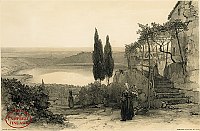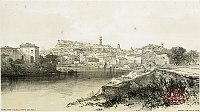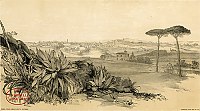Edward Lear (1812 - 1888) - Views of Rome & its Environs
Exhibition
page 1
Edward Lear’s Views of Rome are undoubtedly some of his most splendid topographical prints. These hand drawn original lithographs were the result of his first extended journey to southern Europe and in particular to Italy, the country which was to become his second home. “Drawn from nature and on the stone” by Edward Lear himself, these beautiful views possess a freshness inspired by the artist’s first impressions of a country which was to steal his heart.
Although widely known for his achievements in a variety of fields, Edward Lear was a landscape painter by profession and by the time of his first visit to Rome he was already an accomplished lithographer. It is clear that Edward Lear planned a sumptuous series of original lithographs from his first extended journey to Southern Europe from the outset. Edward Lear travelled throughout Italy, staying primarily in Rome for a period of over four years between 1837 and 1841. During this time he built up a collection of sketches from which these lithographs could be prepared. Upon Edward Lear's return to England he worked these up into elaborate reversed drawings, made directly upon the lithographic stones. He arranged for the printing of these to be handled by C. Hullmandel, probably the most famous lithographic printer of the era.
For each of these prints, a separate tint stone was used. This printed the pale orange-yellow or greyish background tonal tints, which provide the delicate shading and bright highlights for the designs. The final result is far more pleasing and atmospheric than could have been attained using black ink alone, the carefully varied colouration and strength of background tint having added both warmth and beauty to these attractive Mediterranean views. The only edition of these lithographs was issued exclusively to subscribers and was apparently limited to 209 sets (no impressions of Lear's Views of Rome were issued hand-coloured - any such impressions have been coloured up many years subsequently by recent hands). Individual impressions of Edward Lear's Views of Rome as issued in 1841 provide some of the most attractive and affordable works by this great artist.
Although widely known for his achievements in a variety of fields, Edward Lear was a landscape painter by profession and by the time of his first visit to Rome he was already an accomplished lithographer. It is clear that Edward Lear planned a sumptuous series of original lithographs from his first extended journey to Southern Europe from the outset. Edward Lear travelled throughout Italy, staying primarily in Rome for a period of over four years between 1837 and 1841. During this time he built up a collection of sketches from which these lithographs could be prepared. Upon Edward Lear's return to England he worked these up into elaborate reversed drawings, made directly upon the lithographic stones. He arranged for the printing of these to be handled by C. Hullmandel, probably the most famous lithographic printer of the era.
For each of these prints, a separate tint stone was used. This printed the pale orange-yellow or greyish background tonal tints, which provide the delicate shading and bright highlights for the designs. The final result is far more pleasing and atmospheric than could have been attained using black ink alone, the carefully varied colouration and strength of background tint having added both warmth and beauty to these attractive Mediterranean views. The only edition of these lithographs was issued exclusively to subscribers and was apparently limited to 209 sets (no impressions of Lear's Views of Rome were issued hand-coloured - any such impressions have been coloured up many years subsequently by recent hands). Individual impressions of Edward Lear's Views of Rome as issued in 1841 provide some of the most attractive and affordable works by this great artist.
| There are 26 prints split over 3 pages This is page 1 | [ page 1 ] - page 2 - page 3 |












